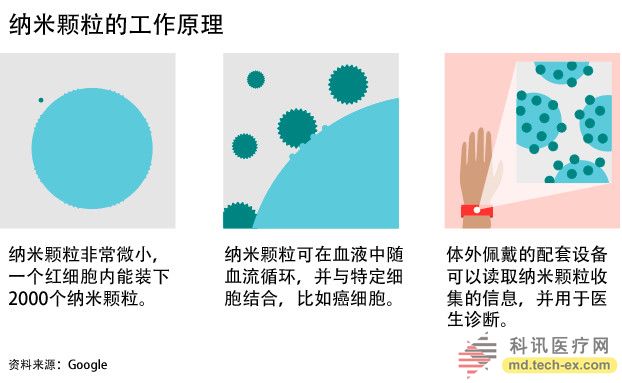Release date: 2014-10-31
Google is developing a new technology that combines nanoparticle and wristband sensors that can detect disease. The nanoparticle can be taken into the patient's blood after oral administration through a capsule, and a slight change in the biochemical index of the human body can be detected as an early warning system for the disease. Currently, this project is still in the initial stage of research and development.
Early diagnosis is the key to treating the disease. Many cancers, such as pancreatic cancer, can only be detected when they are in an incurable and fatal stage. In fact, cancer organizations and health organizations are very different, so Google hopes to use continuous blood monitoring to detect early signs of cancer, and to make early diagnosis before any physical symptoms occur.
The project is led by Google's R&D department, Google X, which has been working on disruptive innovation with unlimited potential. Google has recently had many new attempts in the medical field, including the previously developed blood glucose measurement contact lenses for diabetics, the acquisition of anti-shake spoons for patients with Parkinson's, and the purchase of Calico, which provides anti-aging products. Share of 23andMe Corporation of Personal Genetic Testing Kit.
Swallow a handful of nanoparticles?
The project was led by molecular biologist Andrew Conrad. Conrad has previously invented a cheap HIV test that is now widely used. He said: "What we want to do is to transform medicine from post-onset treatment to active prevention, and nanoparticles allow us to understand the physical condition at the molecular and cellular levels."
Google is designing a series of nanoparticles for biomarkers in different situations. They can be attached to a cancer cell or a piece of cancer cell DNA, or they can be used to find evidence that fat plaques on the blood vessel wall are about to fall off, because once these plaques block blood flow, they can cause heart attacks or Stroke.
Another series of nanoparticles can continuously monitor chemicals in the blood. Because potassium levels in the body are too high in relation to kidney disease, Google believes that porous nanoparticles can be made, and the color changes when potassium ions pass. Conrad said: "Then you can use magnetic fields to gather these magnetic nanoparticles, such as the superficial blood vessels at the wrist, and then you can see their color."
Unbound nanoparticles and those particles wrapped around cancer cells have different modes of motion in the magnetic field. In theory, using software to study their dynamics can make a diagnosis. As part of the research, the researchers also explored ways to use magnetic fields to bring nanoparticles together in the same place in a short time. Google’s ultimate goal is to create a wristband that reads readings on nanoparticles by light and radio waves one or more times a day.

Will it lead to over-treatment?
Dr. Paul Workman, the top director of the London Cancer Institute, said: "In theory, this method is very good, and any new force that proposes new ideas in the field will be welcomed. We really need this invention. If you can detect cancer or other diseases earlier, you can intervene as soon as possible through lifestyle changes or treatment. It is too early to say this is unrealistic, because this is a very good idea, now to do It is practice."
His team is working on cancer cells and cancer-associated DNA in the blood as a new way to diagnose and plan treatment. He reminded Google that diagnosis can increase people's anxiety and may lead to over-treatment, so careful and rigorous analysis must be used before this blood monitoring method can be widely used.
Google announced the plan because they are looking for partners. But Conrad doesn't want people to think that Google wants to develop a set of search tools on the human body in addition to the web search engine. He said: "Although we invented this technology, we did not intend to commercialize it or use it to make money. We will delegate it to partners and provide it to doctors and patients. This is not a consumer product. It's a prescription medical device. We all know that the doctor-patient relationship needs to be kept secret, so Google will not be involved."
From searching the web to searching your blood, it's clear that Google's goal is huge, but is this feasible? The basic principles are reasonable and relevant work is now being carried out around the world. Many research groups are considering using a small number of cancer cells in the blood as a better way to diagnose cancer and analyzing which cancers are more proliferative. But when a healthy person is diagnosed as having a disease, Google has to solve the "false positive" problem. This problem is plaguing the PSA (Prostate Specific Antigen) test for prostate cancer, as PSA levels also increase dramatically in the absence of cancer.
In addition, there is the problem of over-diagnosis, that is, if a condition is discovered, whether or not treatment is needed. For example, there has been controversy over the issue of breast cancer screening. For every serious breast cancer patient, three women have been treated for trauma because they are not fatal. There are risks everywhere in the process of screening for a disease. If this process is not done carefully, everyone may become a suspected patient.
Source: Shell Network
Best Neck Massager,Shiatsu Neck Massager,Neck Relax Massager,Best Massage For Neck Pain
Shenzhen Jie Zhong Lian Investment Co., Ltd. , https://www.szmeizon.com